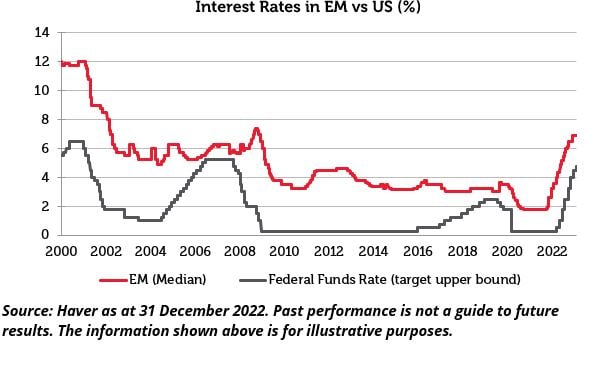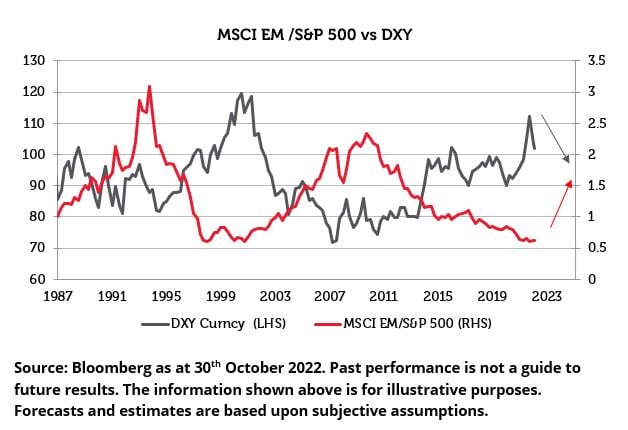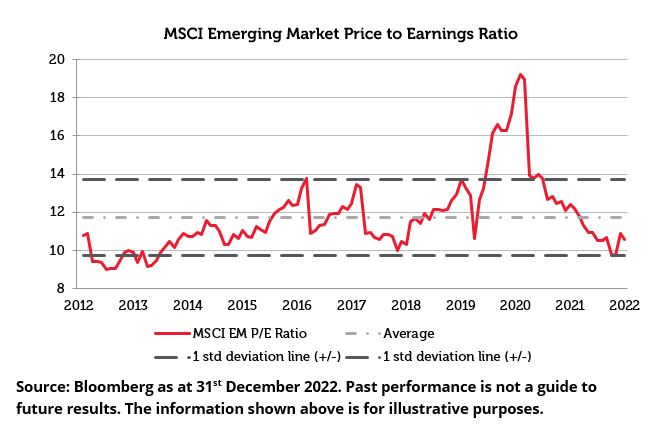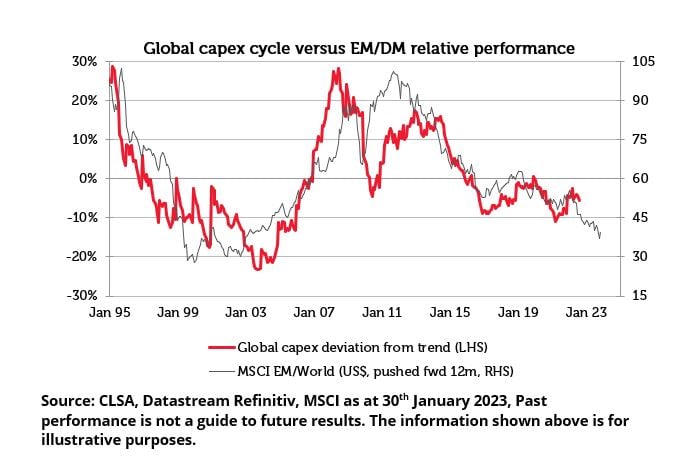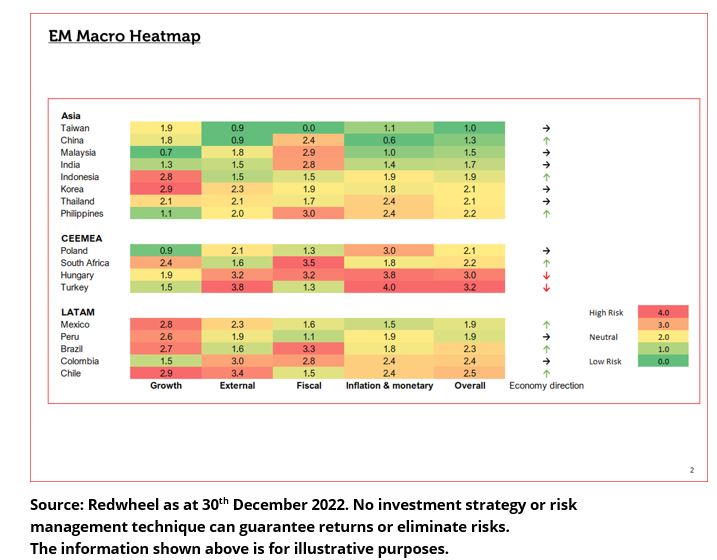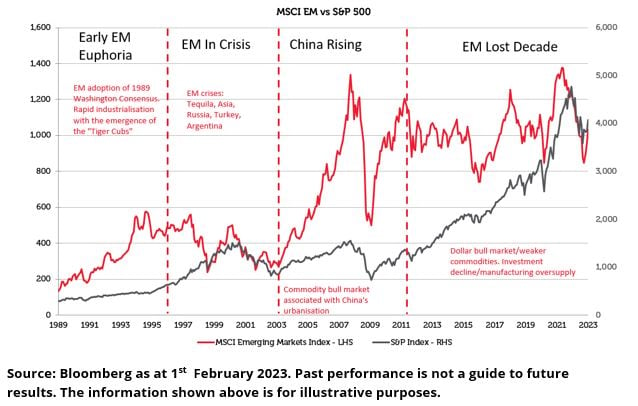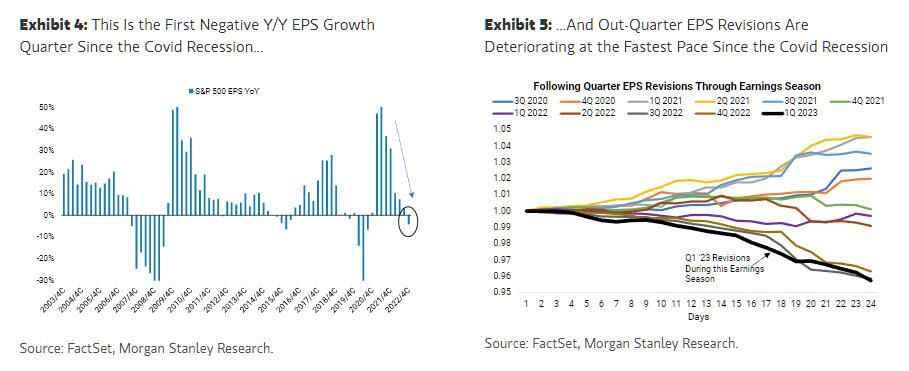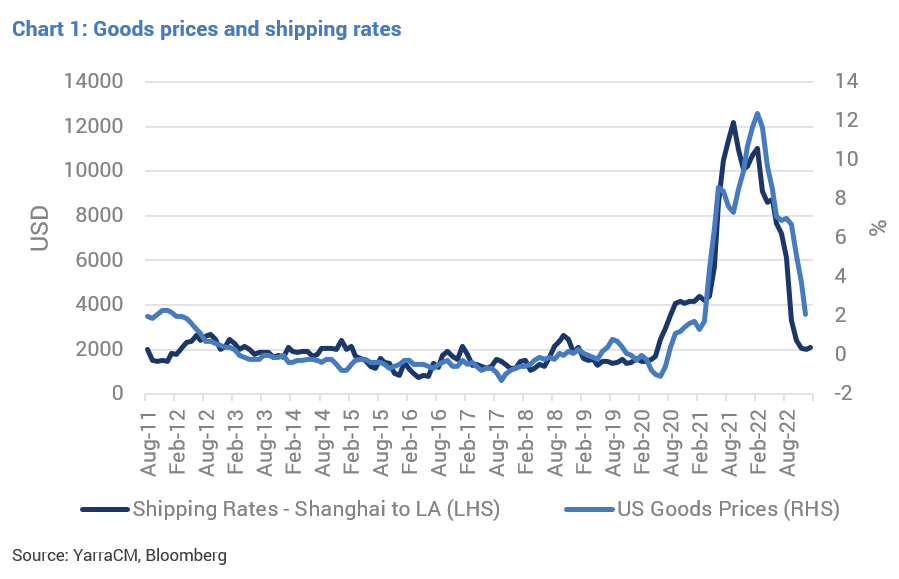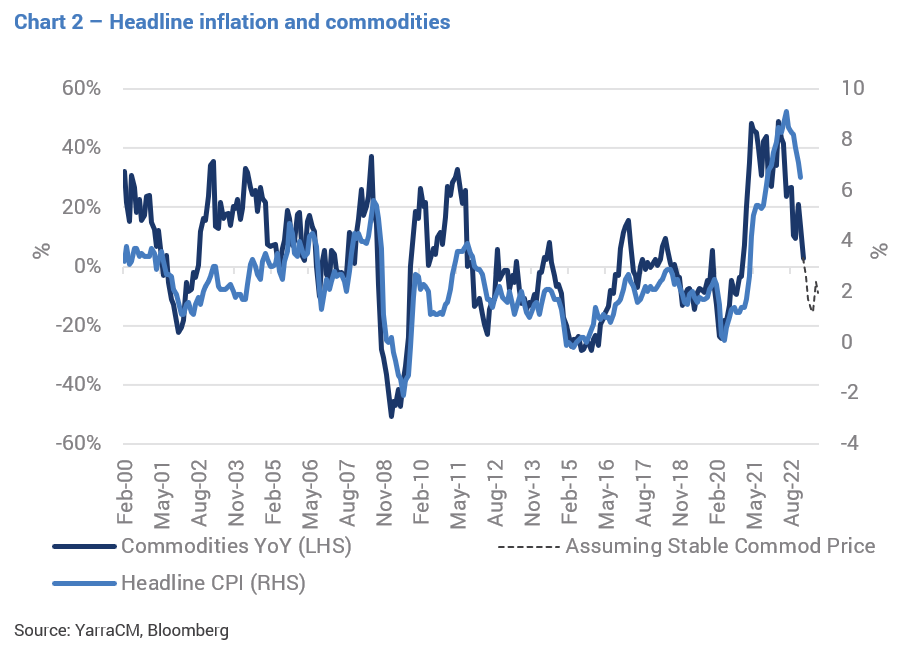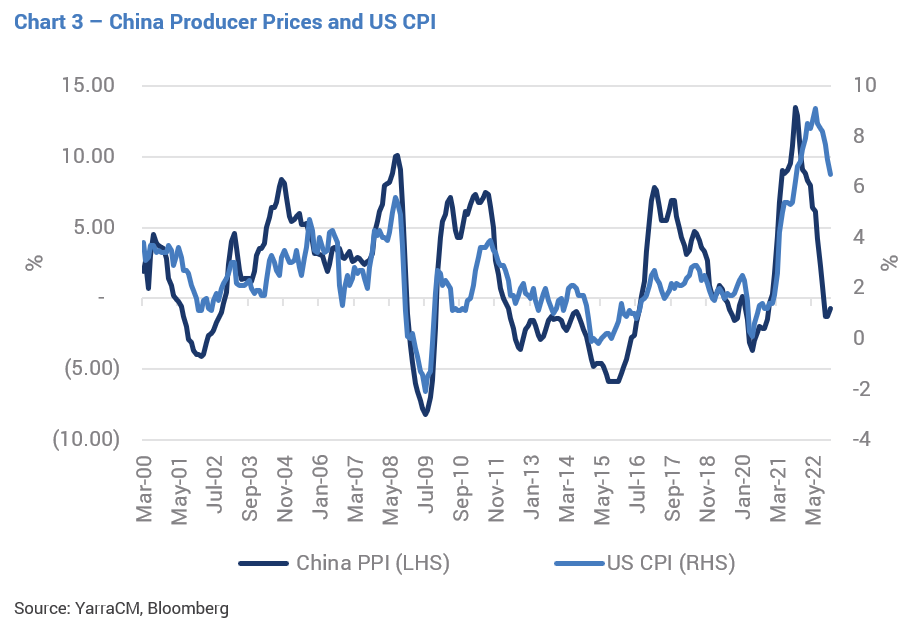NEWS

15 Mar 2023 - 2023 Outlook for Emerging Markets
|
2023 Outlook for Emerging Markets Redwheel (Channel Capital) February 2023 Emerging Markets faced three main headwinds in 2022, namely, China's zero Covid-19 policy, aggressive monetary policy tightening globally and the Russian invasion of Ukraine. We see two out of those three factors turning into potential tailwinds in 2023. Firstly, China has already started to reopen its economy; therefore, the main question is the impact on the rest of the world. Secondly, we see the Fed pausing hikes at some time in H1 2023 and potentially pivoting to rate cuts in Q4 2023, which could lead to a weaker US dollar. The combination of a dovish Fed and the reopening of China's economy creates a favourable backdrop for Emerging Market (EM) equities to outperform. Additionally, there are other factors that we think will contribute to the outperformance of EM in 2023:
Looking at the 8 factors in more detail: 1) A dovish Fed - As discussed, we believe the Fed will pause rate hikes and then begin to cut rates later this year. Moderating US rates should take the pressure off EM central banks, which have already tightened significantly, remaining ahead of the curve. So far, the only emerging economy central bank with an easing bias is China. Looking forward, we anticipate that countries such as Brazil should also cut rates in 2023.
2) A Relaxation in China's Covid-19 policy - China is the world's second-largest economy and accounts for over one-third of global growth.[1] The prospect of a China reopening is a key catalyst for many EM economies and stock markets in 2023.[2] We anticipate that China's re-opening will benefit companies across our investment universe. For example, Chinese travel spending was ~$100bn in 2022 but as Covid mobility restrictions are removed, we anticipate this figure could return to pre-Covid levels of ~$250bn in 2023. This spending should impact travel-related companies in China, as well as companies in other countries that are beneficiaries of Chinese tourism, such as Indonesia and Thailand. A faster than expected removal of Covid restrictions continues to support growth sentiment and a rotation back into stocks relying on Chinese consumption and supply chains, as well as having a significant effect on the commodity market. 3) Accelerating emerging vs developed real GDP growth differential - We believe that economic growth is likely to increase in EM during 2023, bolstered by China and LatAm. In contrast, we think Developed Markets (DM) GDP growth is expected to decline close to zero. As a result, the growth differential between EM and DM could widen in 2023 and 2024. This sets a strong backdrop for EM asset prices.
4) Emerging markets will likely benefit from a dollar bear market or a period of dollar weakness - The interest rate differential moved in favour of US dollar-denominated assets as the Fed raised policy rates more rapidly than its developed market counterparts. On the other hand, China continued to ease monetary policy. The flow of capital to the US accelerated when the Fed signalled an even tighter monetary policy than the markets were expecting in March 2022. - Going forward, we expect that the Fed's hawkishness will fade with decelerating inflation in the US due to the lagged effects of monetary tightening. As the Fed begins to become less hawkish and the ECB continues playing catch up on tightening, the interest rate differential should gradually lead to a rotation away from US dollar-denominated assets. This historically has led to EM outperforming the S&P (as seen below).
5) Stronger relative emerging market EPS growth - EM earnings expectations have already been revised to prudent levels. Looking ahead, we anticipate that the lower base should lead to increased growth of corporate earnings within EM. Additionally, there should be more price stability and a chance for favourable market surprises.
6) Evidence of investor capitulation - After the longest market drawdown in history, investor positioning in EM equities is light. Over the past 13 years, the pace of foreign net selling was only swifter in 2009 and 2020.[3] As news flow surrounding China becomes incrementally more positive, we believe we are at a turning point in investor sentiment towards emerging markets. 7) Favourable valuation dynamics - Emerging equities are trading on 10.5x P/E ratio, cheaper than the 10-year average of 11.7x. In contrast, US equities trade on a multiple of 29.1x. As a result, current valuations appear attractive in comparison to other markets and in our view offer a great buying opportunity for long-term investors.
8) A global capex recovery post years of structural disinvestment - Corporates are recording an early stage—almost involuntary—uptick in investment as the capex depreciation ratio dipped to a record low in 2021. Indeed, for developed equities the ratio fell below parity for 18 months, indicative of depreciating assets not being fully replaced. - Emerging Markets relative outperformance has historically been a function of the global capex cycle given that the sector composition is heavily skewed towards capex plays.
Regional Outlook We believe that China is expected to benefit from greater policy impetus following a period of destabilising politics over the past 2 years. This is already evident by several Covid-related policies and increased support for the real estate sector. We see political, economic and covid policies becoming more aligned in the domestic market while external conflicts taper off. This should allow China to continue outperforming going forward. Looking at India, the long-term investment case has strengthened in recent years and we believe the market provides a strong structural growth story. Valuations are expensive, but this comes on the back of strong earnings. External factors, such as crude oil, have turned favourable and domestic indicators continue to be encouraging. South Korea and Taiwan should benefit from a global cyclical recovery and an improvement in prospects for the semiconductor and tech hardware sectors. In Latin America, Mexico appears set to benefit from nearshoring due to its close proximity to North America. Brazil, having significantly tightened their monetary policy and will benefit from an easing monetary policy cycle as well as high commodity prices. The Middle East should continue to benefit from elevated energy prices while it diversifies its economy away from oil and broadens its capital markets. South African equities should benefit from our views on US and mainland China, even though the domestic macro trajectory is somewhat anodyne. For smaller EM and frontier markets (FM), idiosyncratic growth drivers are expected to drive asset prices. Our key themes: Commodities, New Factories of the World and Travel, across the smaller emerging and frontier markets remain intact. We have also seen a fall in prices of soft commodities. This may alleviate pressures on those countries such as the Philippines that are net importers of commodities and may abate food inflation concerns. In addition, a higher oil price is also a tailwind for many FM countries. While oil prices should remain elevated, the rate of change in oil prices should decline. The muted increases should contribute to an overall decline in inflation and allow central banks to cut rates going forward.
Commodities We believe that the recovery of Chinese demand as a result of its re-opening has the potential to outweigh any weakness in Western demand in the event of a recession. Looking at the oil supply and demand situation, a Chinese recovery to pre-pandemic levels would add 1mbpd to global demand and a full recovery of air travel and jet fuel demand, would add another 1mbpd. Looking at previous global recessions, oil demand has fallen on average by c.1mbpd. Therefore, a Chinese re-opening and economic recovery should have the capacity to more than offset any slowdown. China also accounts for more than half of the global demand for base metals and nearly two-thirds in ferrous metals and bulk commodities. For example, China remains a dominant consumer of copper, another of the strategy's key commodity exposures. With a clear sequential recovery path now expected for China in 2023, we believe that we are near the trough in the copper cycle due to a return to relatively healthy GDP growth trend. At the same time, 2022 has again demonstrated the supply constraints to the global copper supply which we expect to persist in the years to come. Long Term Growth Drivers Looking at the longer-term picture, we believe that we are at the cusp of an EM bull market after a "lost" decade in EM. The culmination of the previous 8 factors, though highly supportive for EM equities would ultimately be sufficient to drive a phase of outperformance akin to the 2016/18 episode (26% US$ outperformance over 26m), which albeit welcome at the time, lacked more structural pillars to prolong the rally. History tells us that longer duration EM outperformance is driven by earnings super-cycles where sustained and superior dollarized EPS growth against the US requires a seismic, underlying shift in the EM investment case. We believe this is coming to fruition as the global economy increasingly separates into two major trading blocs, one broadly aligned to the US and the other to mainland China. We think there will be winners from this de-globalisation and we consider four key themes; • Supply chain reorientation/Nearshoring The accumulation of these thematic pillars coupled with the previous 8 factors sets up an attractive growth story going forward.
Conclusion Emerging Markets faced numerous macroeconomic and geopolitical challenges in 2022. Despite the recent obstacles, we believe that the outlook for 2023 is positive and that we are at the cusp of an EM bull market. We expect to see a moderation in US monetary policy and a reopening of the Chinese economy which should improve sentiment and allow EM equity multiples to rerate from currently depressed levels. As a result, we believe EM equities are in a robust position to outperform developed markets and deliver high absolute returns. |
|
Funds operated by this manager: CC Redwheel Global Emerging Markets Fund, CC Redwheel China Equity Fund
Sources: [1] World Bank as at December 2022 [2] Goldman Sachs, Redwhee; and Haver as at 11 December 2022 [3] CLSA, National Stock Exchange, WFE Key information: No investment strategy or risk management technique can guarantee returns or eliminate risks in any market environment. Past performance is not a guide to future results. The prices of investments and income from them may fall as well as rise and an investor's investment is subject to potential loss, in whole or in part. Forecasts and estimates are based upon subjective assumptions about circumstances and events that may not yet have taken place and may never do so. The statements and opinions expressed in this article are those of the author as of the date of publication, and do not necessarily represent the view of Redwheel. This article does not constitute investment advice and the information shown is for illustrative purposes only. |

14 Mar 2023 - Performance Report: Airlie Australian Share Fund
[Current Manager Report if available]

14 Mar 2023 - January Junkyard Dogs
|
January Junkyard Dogs Arminius Capital February 2023 January looked like a great start to 2023, after the losses of 2022. The S&P/ASX200 index was up 6.2% for the month, similar to the 6.3% rise in the US S&P500 index. Share markets in Europe, China and Latin America were even stronger. But appearances can be deceptive. The January rally was built on hope, not facts. Investors were betting that the Fed would stop raising interest rates and the battered tech sector would recover. For example, Tesla gained 40%, Bitcoin jumped 38%, and even the joke Dogecoin rose 32%.
What investors were doing is called bottom fishing: that is, they were buying the assets which had fallen the furthest in 2022, on the grounds that they must be cheap after such big price falls. For example, Meta Platforms (the disaster formerly known as Facebook) fell by 76.7% from peak to trough in 2022. In January 2023 it rebounded by 109.8%: simple arithmetic tells you that it is still down 51.2%, i.e. Meta shareholders have still lost half their money. Is Meta cheap? History suggests it isn't. The investors who are buying beaten-down tech stocks in this cycle are usually too young to remember the aftermath of the 2000 dotcom boom. As PT Barnum said, "There's one born every minute." Older readers will recall that the tech stocks began to slip in April 2000, and kept sliding for the next four years. They did enjoy rebounds every few months, but these were all false dawns as the bear market persisted. The best of the tech stocks - think Amazon, Google, Microsoft - lost about 75% of their value from peak to trough. The rest of the tech stocks just disappeared altogether. In fact, if dividends are excluded, the whole US share market was no higher in 2007 than it had been in March 2000. The January 2023 rally ended in early February as the Fed (and other central banks, including our own Reserve Bank) put an end to investors' fantasies by making it very obvious that interest rates were going higher and staying up for longer. Early reporting from US companies for the December 2022 quarter showed that in many cases profitability was falling short of expectations.
Arminius continues to believe that, even though we are now in the Year of the Rabbit, several of the tigers from 2022 are still hanging around, such as oil prices and the Ukraine crisis, and they have been joined by the problem of Congressional gridlock in the US. The biggest of these tigers is inflation, which is not going back to the sub-2% levels which was obtained in the peaceful decade before Covid. At best, US inflation will abate from 7% to around 4%, but then it will get stuck. The tight US labour market is pushing up wages in key sectors, and companies are pushing through price increases in order to pass on increases in wages and input costs. Persistent inflation means that the Fed will not cut interest rates as quickly as the bond market is hoping. At worst, US inflation will fall slightly then begin to rise again, e.g. because of external factors such as higher oil prices or higher commodity prices. Under these circumstances, the Fed may have to raise interest rates again ala the Ghost of Arthur Burns past. The outlook for Australia is better than the outlook for the US, and we expect the Australian share market to outperform the US over the next three years. This has nothing to do with domestic Australian policies; if anything, it's in spite of. The main drivers of this positive outlook are China and the resources boom. The Chinese economy is not recovering as fast as the bulls might hope, but it will be back to pre-Covid levels by late 2023. In addition, the Chinese government is quietly stepping back from its unofficial bans on Australian exports from coal to lobsters. Global de-carbonization is fueling a resources boom which will focus on the minerals used in batteries and clean energy generation, "critical minerals" such as copper, nickel, cobalt, graphite and lithium. This latest resources boom means that Australian investors will enjoy a rising A$ against most major currencies, which will also help to curb domestic inflation. US investors, by contrast, will see the US$ continue to weaken, which tends to mean importing inflation. The single most important thing for investors to remember in 2023 is that the world has changed. We are not going back to the world of ultra-low interest rates because inflation is not going away, and the forty-year bull market in bonds ended abruptly and painfully in 2022. This paradigm shift means that investors need to question the habits which they have built up since the GFC, and adjust their investment strategies to a world of higher volatility, where real assets will outperform financial assets. Australian equities will perform better than most of the world over the next three years, but the new paradigm of higher volatility means that the old strategy of buy-and-hold won't work very well in a world where commodities and resource companies lead share market performance. To cope with the coming turbulence, investors will need exposure to commodities and to long/short strategies - i.e. the ability to short shares as well as buying them. The Arminius Capital "ALPS" strategy returned +21.67% in 2022, compared to negative -19% for the US S&P500 and negative 1.1% for Australia's S&P/ASX200. The 2022 return puts ALPS among the top 3 out of 39 alternative funds. The key factors behind the ALPS annual return of +21.6% were to invest in commodities and to invest long/short. Funds operated by this manager: |

13 Mar 2023 - Performance Report: L1 Capital Long Short Fund (Monthly Class)
[Current Manager Report if available]

13 Mar 2023 - Performance Report: Cyan C3G Fund
[Current Manager Report if available]

13 Mar 2023 - The Long and The Short: Could the year ahead defy the Fed?

13 Mar 2023 - New Funds on Fundmonitors.com
|
New Funds on FundMonitors.com |
|
Below are some of the funds we've recently added to our database. Follow the links to view each fund's profile, where you'll have access to their offer documents, monthly reports, historical returns, performance analytics, rankings, research, platform availability, and news & insights. |
|
|
|||||||||||||||||||
| Argonaut Australian Gold Fund | |||||||||||||||||||
|
|||||||||||||||||||
 |
|||||||||||||||||||
| Maxiron Monthly Income Trust | |||||||||||||||||||
|
|||||||||||||||||||
| View Profile | |||||||||||||||||||
|
Want to see more funds? |
|||||||||||||||||||
|
Subscribe for full access to these funds and over 700 others |

10 Mar 2023 - Hedge Clippings | 10 March 2023
|
|
|
|
Hedge Clippings | 10 March 2023
Let's have a real conversation about tax! Following the flurry of indignation, debate, and media comment raised by the government's changes to super balances over $3 million, everything seems to have gone quiet. Maybe this is just the temporary or short-lived nature of the news cycle, or possibly that it's hard to maintain the rage or focus on something that affects less than 1% of the population, and a seemingly privileged one at that. However, that doesn't change a couple of key issues we have with Dr. Jim's "discussion" with Australians about the purpose of their super. Firstly, the increased 30% tax rate is triggered by the value of the asset, not the amount of income earned. Secondly, if triggered, tax is payable on both realised and unrealised gains. However, those are just the details. What also seems illogical is that Treasury forecasts estimate the new tax will raise just $2 billion out of almost $250 billion a year in concessions, or less than 1% of the total. Watch out, because what the government would really like to do is to come after some of the remaining 99% if they can. Of course to do that - as Bill Shorten discovered in 2019 - they'll upset far more voters than the 0.5% impacted by their current plans, most of whom are unlikely to be Labor voters in the first place. Of course, what is needed is a total review or conversation, not only around super but the overall taxation system in Australia. We had one of those in the form of the Henry Tax Review (aka Australia's Future Tax System Review) announced by then PM "Kevin '07", in 2008. Having taken 2 years to prepare, this was handed to the hapless Rudd two days before Christmas in 2009, but not released until May the following year. For the record, Kevin Rudd was also careful to shackle Henry's review before it started. It was not allowed to consider increasing the rate of, or broadening the base of the GST, or consider imposing tax on super payments to retirees aged over 60! Henry's report made 138 recommendations grouped under 9 broad themes. Rudd implemented just 3 of the 138 changes suggested in the report, lost his job over one, the proposed resources Super Profit Tax, which became the Minerals Resource Rent Tax (MRRT), passed in 2012 under Julia Gillard, and promptly repealed by Tony Abbott in 2014. History shows it is wise to choose your targets carefully, and avoid upsetting the powerful, and in the case of the resources Super Profit Tax, well resourced (pun intended) self interested companies, 83% of which were reportedly offshore owned. History also shows the futility of trying to overhaul or change the existing system, however broken, inefficient, or inequitable it may be. Most of Henry's report and its recommendations remain in the too hard basket, gathering dust. Some, such as a reduction in company tax, have been partially implemented. This leads us to two questions: Firstly, will we ever get the reform Henry's review proposed, such as just two levels of personal income tax and a much higher tax free threshold ($25,000), across the board company tax of 25%, and a simplification of superannuation, deductions, and offsets? And secondly, will any politician ever dare to increase the GST from its current 10%, and broaden its base in return for a reduction in personal income tax? This 2020 report from PWC estimated that by increasing the GST rate to 12.5% and broadening the base to include water, childcare, health, education, and food, it would generate $40 billion a year - so a rate of 15%, (as it is in New Zealand) let alone 20% (the OECD average rate is 19.3%), it would presumably take that towards $100 billion. The answer to both questions is "unlikely" given the political pain involved. However, that's the conversation Dr. Chalmers needs to have with Australians. And then get on with it! |
|
|
News & Insights New Funds on FundMonitors.com Market Commentary | Glenmore Asset Management Investment Perspectives: 10 charts for optimism in 2023 | Quay Global Investors Magellan Infrastructure Strategy Update | Magellan Asset Management February 2023 Performance News 4D Global Infrastructure Fund (Unhedged) Delft Partners Global High Conviction Strategy |
|
|
If you'd like to receive Hedge Clippings direct to your inbox each Friday
|

10 Mar 2023 - Performance Report: Argonaut Natural Resources Fund
[Current Manager Report if available]

10 Mar 2023 - When inflation meets recession
|
When inflation meets recession Yarra Capital Management February 2023 So, has inflation peaked or not?Given the multi-decade high inflation levels of 2022 was the precursor to aggressive interest rate hikes, a key driver for the 2023 outlook is the direction of inflation. Throughout 2022 three core factors drove higher inflation; supply chain issues, amplified goods demand due to stimulus, and a commodity price shock. All three appear to have peaked. Several economic indicators suggest that supply chain issues are behind us. The supply chain measure provided by the Federal Reserve has fallen, shipping rates between the US and China have normalised (refer Chart 1), and key global exporters such as Korea and Germany are now seeing export orders decline.
Additionally, the impact of central bank rate rises through 2022 should see consumer spending slow in 2023, as the fastest rate hiking period in the past 30 years quickly constrains household budgets. In Australia, we expect to see mortgage costs rise anywhere from 20-60% (for the typical borrower), with those who borrowed on a fixed rate over the past 18 months will see a 60% increase in payments. After an era of cheap money and stimulus provided during COVID, this should take the sails out of the outsized goods demand over the past two years.
While geopolitical risk related to Russia dominated headlines in 2022, commodity prices have begun to fall. Oil is now flat on a year-on-year basis and commodities are declining. Commodity prices are one of the strongest predictors of inflation, and the more benign commodity prices, point to inflation falling away in 2023 (refer Chart 2).
Outside of these factors, several other lead indicators of inflation are beginning to decline. These include producer prices in China dropping to deflationary levels (refer Chart 3).
PMI surveys show that firms are now reporting that input prices are falling, and small business surveys show the number of firms passing on price increases has peaked (refer Chart 4).
While the indicators do not point to a deflationary environment, the speed with which they have shifted, combined with the central bank's aggressive hiking cycle, suggests that we could see inflation back within their target bands by the middle of the year. This would encourage central banks to keep interest rates high but remove their hawkish bias. Signs pointing to rising recession riskThe second factor that is likely to determine interest rates in 2023 is related to recession risk. Historically, when a recession occurs, interest rates fall aggressively as central banks ease financial conditions to boost their economies. This has occurred in every recession over the past 50 years (refer Chart 5).
On average, following a recession, the cash rate dropped by 400 basis points, with smaller decreases only occurring when the cash rate hit the zero bound (refer Table 2). In no instance did the cash rate finish the recession higher or at the same rate it started.
If the US enters a recession in 2023, there will be pressure on the Federal Reserve to cut the cash rate. Currently, several recession indicators are starting to flash red and point to a distressing growth signal. These signals can be seen in the leading index of US growth, new orders, consumer expectations, and housing. For example, the leading US growth index has moved into contraction (refer Chart 6) and is now at a level indicative of a recession, as observed in all of the past eight occurrences.
A warning sign of recession can also be a result of falling indexes including new orders relative to inventories which have now seen the US yield curve invert across multiple maturities (refer Chart 7). Historically, this has preceded a recession by approximately six to 12 months, reflecting monetary policy has become too tight for economic conditions. As with the leading index above, curve inversion has not given a false positive and has preceded all recessions since 1970.
In addition, we are seeing recessionary signals such as a weak housing market and an extreme softening in consumer confidence.
While many may hope that the economy faces an unemployment-less recession, i.e., that unemployment doesn't rise as growth falls, this would be an extremely rare occurrence. Over the past 50 years, unemployment has never remained stable through a recession, rising anywhere from 0.6% to 3% higher over a six-month period. If the US economy does enter a recession, a rise in unemployment should not be far away.
The key takeaway is that we have not seen this many recessionary signals since 2007, creating strong pressure for central banks to ease rates should a recession occur. Interest Rate Outlook - Inflation meets recessionThese two forces produce two very different outcomes for central banks and interest rates. On the one hand, high but slowing inflation should encourage central banks to maintain their hawkish stance, hold rates high and ensure that inflation returns to its 2% targets. However, the deterioration in economic data would historically have seen a dovish tone being adopted by now. So which force should win? The below chart shows that, historically, recession risk dominates. When recession occurred in the '70s, '90s, and '00s, rates fell even when inflation was high. Furthermore, in 1974 and 2008, the cash rate fell before inflation peaked and was still running at over 5%.
Despite this, the Federal Reserve continues to present an extremely hawkish message, expecting to make cash rate moves that take little consideration of the existent lags in monetary policy. The Federal Reserve dot plot (a chart that records each Fed official's projection for the central bank's key short-term interest rate) currently shows an expectation for cash rates to be around 5.5% in 2023. Considering this, it may set up 2023 to be a tale of two halves; higher cash rates to begin the year and lower cash rates mid-year as the Fed acknowledges the recession risks. With this in mind, we believe rates will end 2023 lower than 2022, even if central banks continue to talk a hawkish message in the first few months of this year. If the recessionary indicators prove correct, then rate cuts of 400 points is the magnitude required to restart the economy, which would drag short-dated interest rates into a 1-2% range. The Yield Curve - Flatter short-term, much steeper long termThe yield curve is one of the most consistent series in bond markets as both the driver of its changes and the levels it respects. While bond yields have fallen from 15% to 0%, the spread between the two and 10-year bonds has typically been range bound between -100bps and +250bps. When looking at the two-component rates of the curve, it is easy to see that monetary policy direction is the key driver that determines both steepening and flattening. When the cash rate rises the yield curve flattens, and when the cash rate falls the yield curve steepens. This occurs as the 2-year yield makes larger moves with the change in the cash rate while the 10-year yield is slower-moving. Typically, the 2-year yield moves the fastest to cause large changes in the shape of the curve (refer Chart 11).
We can make two comments about the direction of the curve:
As such, we currently favour a steepening position for three reasons. Firstly, central banks can change their minds and we believe that the magnifying recession signals should not be ignored. If the recession risks are proven true, we should see dovish actions take place sometime in 2023 which will cause the curve to steepen. This idea is backed up by the fact that post-1970, curve inversion has signalled that rate hikes should be coming to an end.
Secondly, the typical flattening cycle occurs over multiple years, while the steepening period is usually far shorter, with the first 100 points of steepening occurring over 9-12 months.
And finally, the curve typically struggles to flatten through -50 to -75 levels that are now broken and take the inversion to historically stretched levels. As such, we are looking to position ourselves to capture the next 200-point move steeper, rather than the last 20-50 points flatter. Is the RBA done with interest rate hikes?While the majority of this outlook has focused on the US, as Australian and US long end rates are highly correlated, for short-dated rates it is important to consider whether or not the RBA has finished its hiking cycle. This is important as the differential between US and Australian short-dated rates is largely determined by the cash rate differential. When the Australian cash rate is higher than that of the US, then 2-year bond yields in Australia will be higher too. Since Australian short-dated bonds remain well below the US, the ability for them to move in a similar nature to the US will depend on the RBA's next action.
One of the key differences between Australia and the US is that the Australian mortgage market is predominantly a variable rate market, while the US mortgage market is fixed. This means the Australian household should feel the brunt of rate hikes faster and at a lower interest rate than in the US. We determine how restrictive monetary policy is by estimating the percentage of disposable income allocated to repaying loans. This measure accounts not only for interest rates but total debt loads and income in the economy. As shown below, the current RBA hikes have already taken this measure to some of the tightest monetary policy settings we have seen in the past 40 years.
Since the Australian policy setting is becoming historically tight, and the global economy is slowing, we believe the RBA is approaching the end of its hiking cycle. If this is the case, 3-year bond yields should have already peaked for this cycle and are currently close to what we consider a fair value. Whether or not short-dated bonds can rally in Australia in 2023 will depend largely on what the RBA does with the cash rate. In previous hiking cycles, if the cash rate can remain stable for 12 months or longer (1995 and 2010), then 3-year bond yields consolidated at those levels for an extended period (refer Table 3). However, when the cash rate held at its peak for only six months (such as in 2000 and 2008), bond yields rallied in anticipation of future cuts and saw yields materially under the cash rate.
Currently, it's too premature to tell whether the RBA will need to cut rates in 2023, as the lead growth indicators for Australia are not as weak as they are in the US. However, if the US and Europe enter a recession, we would expect Australia to follow. Given we are likely near the peak of the cash rate cycle, this effectively sets up an outlook where two outcomes can likely occur. If the global economy avoids a recession, Australian 3-year yields should be somewhat stable and trade around 3.50%. Alternatively, if the global economy continues to slow, we should end the year with yields well below 3%. Therefore, we expect there is a strong likelihood that short-dated yields will end in 2023 lower than in 2022. Author: Chris Rands, Co-Portfolio Manager of the Yarra Australian Bond Fund |
|
Funds operated by this manager: Yarra Australian Equities Fund, Yarra Emerging Leaders Fund, Yarra Enhanced Income Fund, Yarra Income Plus Fund |

